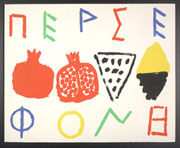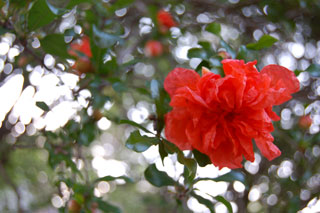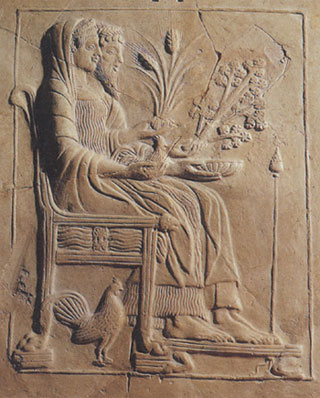Human Flower Project
Friday, May 19, 2006
Persephone’s Flower
Mysterious flames, pomegranate blooms signal the end of spring and, in our part of the world, an oncoming season in hell.
 Persephone
Persephone
Woodcut: Nikos Stangos
The myth of Persephone gets whitewashed for children. We were taught that a lovely maiden out gathering flowers one day suddenly was swallowed down into the underworld. She wanted to go home to mommy (or was it that Mommy wanted her back home?). Anyway, her Mother Demeter, the goddess of all vegetation, was so distressed by her daughter’s absence that she stopped the plants from growing.
Zeus knew the girl was in the Underworld with Hades, and negotiated Persephone’s return. But before the hand-off, Persephone, who’d been warned not to eat anything, slipped and nibbled seven pomegranate seeds. That snack bound her to spend four months back in Hell every year—November, December, January and February—or so we were told. For in much of the Northern Hemisphere that’s when Demeter’s grief turns the green world grey and brown.
We’ve since learned a few things. First, even a mama’s girl like Persephone will stretch the apron strings. It’s not clear whether Persephone (known also as Kore) was abducted and raped or went along with Hades willingly. We do know that she disobeyed Demeter by eating those seeds; nobody forced the pomegranate on her. Like the apple (Fr. pome) in the Garden of Eden, the juicy seeds were too tempting to resist. And it’s no coincidence that the pomegranate fruit is shaped like a uterus.
 Flowering pomegranate
Flowering pomegranate
Punica granatum
Photo: Human Flower Project
Punica granatum holds mystic significance in many cultures. This excellent piece by Paghat’s Garden explores the pomegranate’s place in several religious traditions: Judaism and Christianity, as well as its more familiar appearances in Greek and Roman mythology. Even the Prophet Mohammad advised, “Eat the pomegranate, for it purges the system of envy and hatred.” Other associations are negative, and harken back to Persephone as “bad-girl.”
Horticulturally, pomegranate seems completely free of shadows. The trees are “native to southeastern Europe and Asia and were grown in ancient Egypt, Babylon, India and Iran. Cultivated extensively in Spain, pomegranates moved with the missionaries into Mexico, California, and Arizona in the 16th century.” Blessedly, a big one grows right next to our driveway in Texas and each spring explodes with flowers, firecracker orange.
William Welch, one of our favorite flower experts, writes, “Although of very easy culture, pomegranates prefer a sunny location and deep soil. They thrive in acid or alkaline soils, and tolerate heavy clay as long as there is sufficient drainage. Many forms exist, and not all fruit well. Generally, double-flowering types provide little, if any, fruit.”
That goes for our tree. We enjoy tons of blooms but only a few fruits in the fall.
“In California commercial pomegranate cultivation is concentrated in Tulare, Fresno and Kern counties, with small plantings in Imperial and Riverside counties. There were 2,000 acres (810 ha) of bearing trees in these areas in the 1920’s. Production declined from lack of demand in the 1930’s but new plantings were made when demand increased in the 1960’s.”
Pomegranate fruits—actually the seeds cram-packing the uterine-shaped casing—never have really caught on in the U.S. Pomegranate was held in greater favor during the long eras before refrigeration (Persephone’s time), since the fruits store exceptionally well. In fact, pomegranates, “improve in storage, become juicier and more flavorful” and last for as long as seven months.
As our friends to the north are coming to life, their iris and poppies heralding the happy gardening months ahead, we sense Demeter’s gloom. Now living in the land of the pomegranate, we know Persephone’s season in hell approaches—June, July, August, September.
Martin Nilsson spelled it out in his masterful Greek Folk Religion:
 Persephone and Hades, relief
Persephone and Hades, relief
Reggio, Museo Nazionale
“For people who live in a northerly country, where the soil is frozen and covered by snow and ice during the winter and where the season during which everything sprouts and is green comprises about two thirds of the year, it is only natural to think that the Corn Maiden is absent during the four winter months and dwells in the upper world during the eight months of vegetation. And, in fact, this is what most people do think.
But it is an ill-considered opinion, for it does not take into account the climatic conditions of Greece. In that country the corn is sown in October. The crops sprout immediately, and they grow and thrive during our winter except for the two or three coldest weeks in January, when they come to a standstill for a short time. Snow is extremely rare and soon melts away. The crops ripen and are reaped in May and threshed in June….
“There is a period of about four months from the threshing in June to the autumn sowing in October during which the fields are barren and desolate; they are burned by the sun, and not a green stalk is seen on them. Yet we are asked to believe that during these four months the Corn Maiden is present. Obviously, she is absent.”
Looking again at the myth, we recall that Demeter’s girl was gathering flowers when she sank—whether by force or choice—to the underworld. It was the end of spring, as it now is here. The “blizzards” of June will soon be upon us. We hope Persephone remembers to take a pomegranate or two with her for the long summer ahead. She’s going to need them.
Cooking • Culture & Society • Ecology • Gardening & Landscape • Religious Rituals • Permalink




